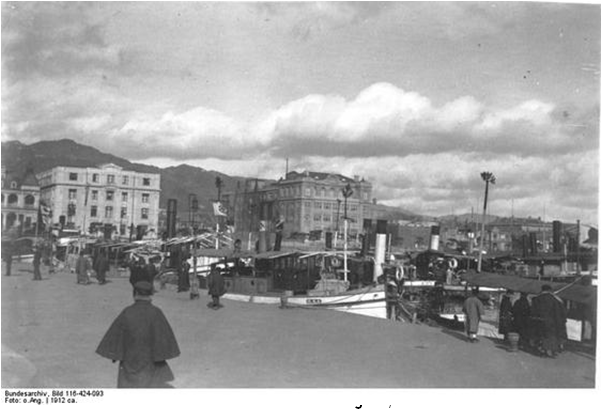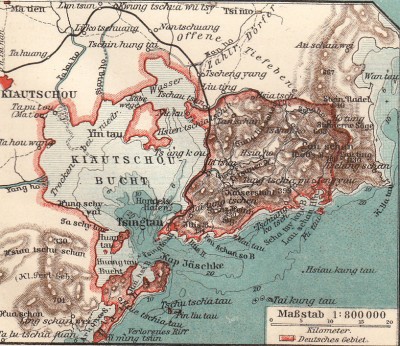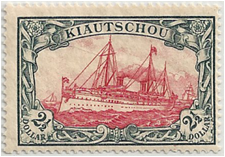ALBUM – view my Kiautschou album
Fast Facts
Region: China Area
Group: German Colonies and Offices in China
Classification: Colony (German)
Prior Regime: The Empire of China
Key Dates:
1897, Nov 14 – Germans invade and occupy Tsingtao
1898, Mar 6 – Germany and the Chinese Empire agree to a 99 year concession
1911 – Chinese Empire falls
1914, Aug 23 – Republic of China cancels the lease
1914, Nov 7 – Kiautchou bay attacked and occupied by the Japanese Empire
Following Regime: Japanese Occupation of China
Scott Catalogue: (Kiauchau) #1-42
Pick Catalogue: (China, Foreign Banks in China) #s261-s303
History

With the defeat of China by Japan in the Sino-Japanese war (1894-95), European powers began to view China as terminally weak and doomed to failure. In order to capitalize on this, they adopted a policy commonly called “carving up the Chinese melon.” The British obtained the New Territories around Hong Kong, the Russians, Port Arthur and the Germans set their sights on the Bay of Jiaozhou Bay (Kiautschou in German).
On 1 November 1897, two German missionaries were murdered in the small fishing village of Tsingtao (today Qingdao), which provided an “excuse” for the German military to move in the region to “stabilize and protect” their citizens in the area. Soon, the powerful Germans were able to force the Chinese to agree to a niney-nine year lease of the region around Jiaozhou bay. Known as the Kiautschou Bay Concession, the agreement gave the German Empire sovereignty over the region, while officially it remained a part of China. Additionally the agreement it gave Germany railroad and mining rights, including areas beyond the borders of the Concession.
While Kiautschou was considered a colony, it was administered under the authority of the Imperial Navy rather than a colonial administration. The colony attracted many German businessmen and colonists as they expanded their influence in the region. During the time of the colony, China experienced tremendous change with events such as: the Boxer Rebellion, (1900), the Russo-Japanese War (1904-5) and the fall of the Qing Dynasty and creation of the Republic of China (1911-12),
With the outbreak of World War I, the Republic of China cancelled the Kiautschou lease and Japan issued an ultimatum to the Germans to unconditionally evacuate the colony. Germany rejected the demand, and on 23 Aug, 1914, Japan declared war on Germany and within three months the Japanese were in control of the region.
After the war, the Treaty of Versailles agreed to Japanese claims at the Paris Peace Conference and assigned all German territories north of the equator in the Pacific territories to Japan, which included Jiaozhou Bay. The Chinese government refused to sign the treaty, and eventually, through negotiation led by the US Government, it was agreed that the region would be returned to China, which was realized in February 1922.
Stamps
 ALBUM
ALBUM
From 1897-1901, German and German Offices in China stamps were used for postage in the colony, which can be identified by a “Tsingtao” postmark. In 1900, stamps from the German Offices of China were surcharged “5pf” in Tsingtao and issued in the colony. There are many varieties of these surcharges and they have been extensively forged. If you plan on collecting them, expertization is a must.
In January, 1901, Kiautchou printed and issued stamps using a common key design for German colonies, which featured the Kaiser’s yacht, the SMY Hozenzollern II. The unwatermarked stamps were issued in German currency (100 pfennig = 1 Mark) in thirteen denominations from 3 pfennig to 5 marks.
In 1905, the colony changed its currency to 100 cents = 1 Mexican dollars. Stamps with the new currency were issued on 1 Oct 1905, also on unwatermarked paper.
Shortly thereafter, stamps began to be issued on paper watermarked with the typical vertical lozenge design of Germany. These continued to be issued until the German post office closed with the Japanese occupation on November 7, 1914. It is also important to note that all of these stamps were printed using the “peacetime” printing. Before WW1, German stamps were issued in what is known as the “peacetime” printings. These stamps usually have a clearer, crisper print quality with brighter colors than the “wartime” printings. Often it is hard to determine the difference, even by an expert.
In 1918 and 1919, the 1c, 20c, as well is the dollar denomination stamps were printed in Berlin with “wartime” printing, and were put on sale to collectors. These of course are of lesser value than the stamps from the “peacetime” printing,
Banknotes
In 1907, banknotes were issued by the Deutsch-Asiatische Bank for use across German interests in China (Tsingtau, Hankow, Peking, Shanghai and Tientsin. The notes were issued in denominations of 1, 5, 10, 25, 50, 100, 200 dollars and 1, 5, 10, 20 tales.
Links
Kiautschou Bay concession from Wikipedia
German Yacht Series from Wikipedia
Kiauchau (Kiautschou)from Stamp Collecting World
Banknotes of Foreign banks in China from ASTNotes






Good background. Did not even know this sort of German colony even existed. Started my inquiry after acquiring one Kiauchau stamp and trying to identify a 4c rose “Kiautschou” used stamp. Collecting world stamps again is teaching me a whole lot of language, geography and history. All in one used 1″ piece of paper. Enjoy your website. Very helpful. – Steve
Hi Steve
Welcome to DCStamps, and thank you for the kind words. There are all kinds of places on the site that are obscure and most people are not aware of. I too, learn much every time I do the research for a write up.
Regards
Michael